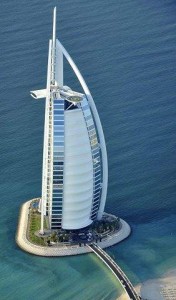By Angela Giuffrida www.thenational.ae
British construction companies have played a major part in laying the foundations for Dubai’s development success.

One of the first to arrive was Costain when it picked up the US$10 million (Dh36.7m) deal to build Dubai International Airport in 1959.
A few years later, Balfour Beatty arrived on the scene and with a local partner, Dutco, built the Mina Jebel Ali port.
As Dubai grew, so did British construction companies.
WS Atkins, the UK’s biggest engineering and design firm, came up with the drawings for the sail-shaped Burj al Arab hotel in 1994, while Carillion helped to build Dubai Festival City.
As the good times rolled, dozens of others joined them, making their marks on projects ranging from the Palm Jumeirah and Dubai Metro to building roads and bridges.
But the financial downturn of the past couple of years has left British builders in a precarious position, with at least one, Mouchel Group, a consultancy company, deciding to pull out.
The company’s once robust earnings from the region tumbled as hundreds of projects came to an abrupt end at the height of the global financial crisis. This time last year, British construction companies were reportedly owed $2 billion in unpaid fees from Dubai developers, spurring Lord Mandelson, the former UK business secretary, to raise the issue with the Government.
Mouchel said it was owed about $16.2m, prompting it to put its regional business division up for sale at the end of last year. A sale is yet to be finalised.
Still, other big players including WS Atkins, Halcrow, Hyder and Mace have vowed to ride out the slowdown, despite facing a struggle to keep staff employed with a sluggish workload.
Even Hopkins Architects, which is embroiled in a legal dispute with Dubai Properties, has said it will keep its office in the emirate open.
“You can’t give up on Dubai,” says Mario Pishiri, a managing director at Hyder, which said in February it had $14.9m in outstanding debts from Dubai clients. “There is a consolidation, but it will come back again … It’s too vibrant a place not to come back again.”
Whether they have made redundancies, asked staff to take a salary cut or moved people to busier locations in the region, British construction firms have undergone a significant overhaul during the past couple of years to cope with tougher market conditions.
WS Atkins, which also designed the Dubai Metro’s Red Line, has cut 1,433 jobs across its Middle East network, bringing the total number employed in the region to 1,867 from 3,300 at the end of 2008.
Keith Clarke, the chief executive at WS Atkins, says it has no intention of “walking away from the Gulf”.
“We’ve been here for 30 years and we’ll be here for another 30,” he says. “We’re very comfortable that the region has a secure, long-term future. We see it as having the same financial issues, frankly, as the rest of Europe and America – only theirs came rather more abruptly, and a bit later than the rest of world. But they are getting solved at about the same rate as the rest of the world.
“The Middle East is not different materially. It had a phenomenal boom and will return to a more normal market.”
Perhaps the speed at which Dubai is seeking to settle its debts has helped to instil confidence in British construction companies.
While payment problems across the board persist, Nakheel, the troubled Dubai World-owned developer, provided a glimmer of hope last month when it started paying its trade creditors.
Halcrow, an engineering company which was owed money for work done on Nakheel’s Palm Jumeirah, has received the first 40 per cent of its outstanding bills.
The UAE is not a market that Halcrow is going to turn away from, says David Yaw, the company’s regional managing director.
“We’re in it for the long haul and are still seeking to ‘defend’ our position in what we regard as our home markets,” he says.
“That said, we recognise that Dubai in particular is going to be quiescent for some time. There are some signs of recovery but it is not going to rebound quickly to anything like the activity levels we saw within the last five years, which frankly is not desirable as it was so overheated.”
And there are distinct signs of recovery. Government spending on infrastructure projects, whether for roads, schools or hospitals, has encouraged companies including the consultancy Mace to shift their focus towards various areas of the construction sector and different countries in the region.
“To compensate for the loss of markets in the UAE, our strategy has been to actively develop our business across the region, focusing on countries such as Saudi Arabia, Qatar, Kuwait and Syria, where demand remains and is increasing for project and construction management services,” says Andrew Johnson, a director at Mace.
While companies are weighing up their options across the region, others point to the UAE’s downturn as a prime time for seizing opportunities.
Wates Construction International, which has built 26 schools in Britain, moved to Abu Dhabi late last year to make the most of the emirate’s spending on educational facilities.
Even though competition is tough, Wates recently won two contracts worth a combined $58.5m to build a school and renovate another for Aldar Academies in partnership with Abu Dhabi’s Al Fara’a Contracting.
“The market is ferocious and speaking to our partner, Al Fara’a Contracting, this is the most difficult period they’ve experienced for many decades,” says Matthew Kennedy, the director of Wates.
“But we came to Abu Dhabi when the market was flat with a view to taking advantage when things recovered.”


















